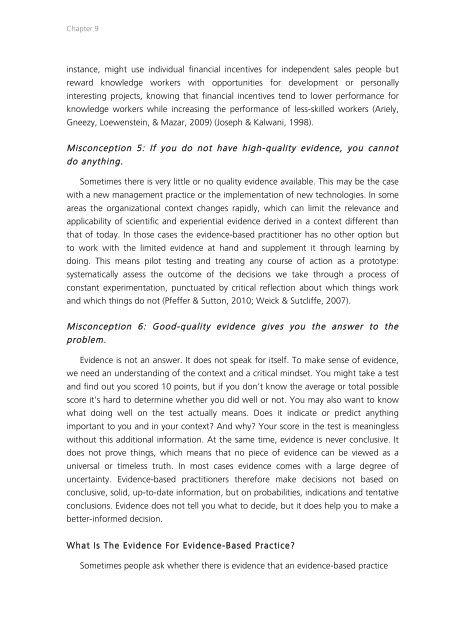In Search of Evidence
jqluvth
jqluvth
Create successful ePaper yourself
Turn your PDF publications into a flip-book with our unique Google optimized e-Paper software.
Chapter 9<br />
instance, might use individual financial incentives for independent sales people but<br />
reward knowledge workers with opportunities for development or personally<br />
interesting projects, knowing that financial incentives tend to lower performance for<br />
knowledge workers while increasing the performance <strong>of</strong> less-skilled workers (Ariely,<br />
Gneezy, Loewenstein, & Mazar, 2009) (Joseph & Kalwani, 1998).<br />
Misconception 5: If you do not have high-quality evidence, you cannot<br />
do anything.<br />
Sometimes there is very little or no quality evidence available. This may be the case<br />
with a new management practice or the implementation <strong>of</strong> new technologies. <strong>In</strong> some<br />
areas the organizational context changes rapidly, which can limit the relevance and<br />
applicability <strong>of</strong> scientific and experiential evidence derived in a context different than<br />
that <strong>of</strong> today. <strong>In</strong> those cases the evidence-based practitioner has no other option but<br />
to work with the limited evidence at hand and supplement it through learning by<br />
doing. This means pilot testing and treating any course <strong>of</strong> action as a prototype:<br />
systematically assess the outcome <strong>of</strong> the decisions we take through a process <strong>of</strong><br />
constant experimentation, punctuated by critical reflection about which things work<br />
and which things do not (Pfeffer & Sutton, 2010; Weick & Sutcliffe, 2007).<br />
Misconception 6: Good-quality evidence gives you the answer to the<br />
problem.<br />
<strong>Evidence</strong> is not an answer. It does not speak for itself. To make sense <strong>of</strong> evidence,<br />
we need an understanding <strong>of</strong> the context and a critical mindset. You might take a test<br />
and find out you scored 10 points, but if you don’t know the average or total possible<br />
score it’s hard to determine whether you did well or not. You may also want to know<br />
what doing well on the test actually means. Does it indicate or predict anything<br />
important to you and in your context? And why? Your score in the test is meaningless<br />
without this additional information. At the same time, evidence is never conclusive. It<br />
does not prove things, which means that no piece <strong>of</strong> evidence can be viewed as a<br />
universal or timeless truth. <strong>In</strong> most cases evidence comes with a large degree <strong>of</strong><br />
uncertainty. <strong>Evidence</strong>-based practitioners therefore make decisions not based on<br />
conclusive, solid, up-to-date information, but on probabilities, indications and tentative<br />
conclusions. <strong>Evidence</strong> does not tell you what to decide, but it does help you to make a<br />
better-informed decision.<br />
What Is The <strong>Evidence</strong> For <strong>Evidence</strong>-Based Practice?<br />
Sometimes people ask whether there is evidence that an evidence-based practice


